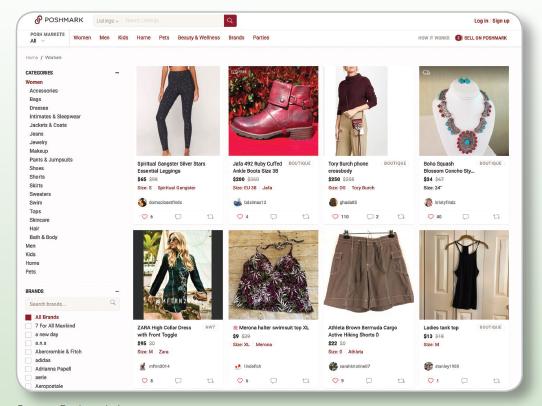What happens when you mix together eBay and Instagram and add millions of buyers and sellers eager
Question:
What happens when you mix together eBay and Instagram and add millions of buyers and sellers eager to shop and purchase items from each other’s clothing closet?
You get Poshmark!
Poshmark is an online marketplace where people can buy and sell clothing from their closets. Since its founding in 2011, Poshmark has focused on creating a compelling online customer experience that transforms social shopping into social commerce. “Our focus was to center the entire selling and shopping experience around people,” explains Manish Chandra, founder and CEO of Poshmark.
THE COMPANY Chandra is a serial entrepreneur who has had a variety of experiences in Silicon Valley. “My first job was working for Intel building databases for semiconductors,” he explains. From there he worked for a series of database companies in California. His first start-up, Kaboodle, was a “bookmarking” site that focused on home décor and allowed people to share links to items they might purchase. Chandra sold the company to Hearst after several years.
His success with Kaboodle led to many insights about the retailing and fashion industries and about trends in consumer behaviors. “We thought that the entire shopping and selling experience was built around products. You list a product and you sell it. We wanted to change that because particularly in fashion the whole experience is built around people,” says Chandra. The growing interest in resale of used products, increasing capabilities of smartphones, and new shopping and selling behaviors sparked by the Great Recession provided a foundation for the Poshmark concept. Chandra’s idea was that the app should be more like window shopping rather than the search-to-buy experience shoppers get on Amazon. In addition, he thought that it was important to introduce people to new fashion through people, not brands. To accomplish this Chandra put together a team of software, retailing, and fashion experts to begin working on the app in his garage. The Poshmark app was designed to let users build a social network around style preferences by allowing people to browse closets and find matching tastes they would “follow,” or by listing their own closet items to attract “followers.”

According to the Poshmark website, the platform offers a “completely new way to shop.” Chandra explains the process for sellers: “Poshmark works in a very simple way. You take your phone and take a couple of photos, you create a listing, the listing then gets shared to all of your followers, and you keep building followers and sharing listings. When people buy, the entire process is automated. You get a shipping label, you ship the item to the buyer, and you get your money.
Super simple on the transaction side, and really fun!”
The process is equally simple for buyers who follow three steps: discover items, follow recommendations of the sellers, and receive the order within two days through Priority Mail.
Today Poshmark has 60 million community members and has more than 100 million items for sale.
Approximately 8 million of the users are also sellers, or “seller-stylists,” and they have generated more than $2 billion in revenue for themselves. While there are several other apps that facilitate clothing sales such as The RealReal and thredUP, there are some differences in Poshmark’s approach. For example, Poshmark is a peerto-
peer shopping app and it encourages interactions among members of the community. Poshmark offers products for women, men, and children.
THE RESALE CLOTHING MARKET Buying and selling used clothing is not a new practice, although today there are many terms such as pre-owned, pre-loved, recycled, secondhand, and vintage used to describe the products. For more than 100 years Goodwill Industries and the Salvation Army have resold used clothing donated by consumers for philanthropic reasons.
In 2024, these “thrift” shops are expected to post sales of $28 billion in the United States alone. Buying and selling used clothing also occurs in consignment stores. In consignment stores, the owner of used clothing contracts with a store to display and price items.
The owner of the used clothing is paid a percentage of the selling price. Well-known brick-and-mortar consignment store chains in the United States are Plato’s Closet and Buffalo Exchange. Online consignment stores include thredUP, The RealReal, Kidizen, and Vestiaire Collective.
Other online shops, such as Poshmark, Depop, Grailed, and Vinted, offer a variation on the consignment stores because owners of used clothing manage their own displays, descriptions, and prices. The transaction is directly between a seller and buyer. Sales of used clothing in the United States through brick-and-mortar and online consignment stores are projected to reach $36 billion in 2024. Other online sites often focus on a type of product such as diamonds and high-end jewelry (e.g., Worthy), or offer all types of products (e.g., Mercari, OfferUp).
Generation Y and Generation Z consumers engage most actively in the used clothing market as both buyers and sellers. They do so for environmental and economic reasons. Gen Y and Gen Z consumers typically embrace the notion of a circular economy, which emphasizes the reuse rather than disposal of products. They also believe that fast-fashion (notably Zara and H&M) brands and wear-once clothing (such as holiday party and wedding events) waste resources and their disposal is bad for the environment. Their concern about waste is for good reason. Waste disposal industry analysts report that the equivalent of one garbage truck of apparel is dumped in landfills or incinerated every second in the United States.
Gen Y and Gen Z consumers are also shrewd and knowledgeable about the price and cost of branded used clothing. They understand the value of well-respected clothing brand names. Used clothing sellers clean out their closets for extra cash, and buyers concerned about their finances actively hunt for bargains. The most popular used clothing categories and represented brands are (1) bags (Tory Burch backpack, Gucci satchel); (2) outerwear (Patagonia jacket, Burberry coat); (3) dresses (Anthropologie, Prada); (4) boots (Frye, Doc Martens);
and (5) sweaters (Veronica Beard cashmere sweater, Coach wool sweater).
CREATING THE POSHMARK SOCIAL COMMERCE EXPERIENCE Poshmark’s success at social commerce is the result of several important web design elements and the company’s marketing actions. As Chandra’s team members formulated their strategy they considered the importance of the context and content of the website. The focus on clothing and fashion meant that the images and photos would be important to users. Poshmark’s guidelines to sellers encourage them to take creative photos and utilize the high-quality cameras now available on many smartphones. In addition, Poshmark has introduced Posh Stories, a social feature that allows users to create shoppable video clips.
Website customization is achieved through a variety of features. First, website users, or “Poshers,” are encouraged to find other users who have a similar fashion taste (and size) and click to “follow” them. The result is every time they add a new post, “followers” receive a notification. A Notifications feature also allows users to receive messages about follows, likes, comments, and reminders. Poshmark users can also use the Shop tab, bookmarks, and filters to customize the offerings they see by category, brand, and size. In addition, the Poshmark website offers a connection design element by providing links to Facebook, Twitter, Pinterest, and Instagram.
The Poshmark team emphasizes communication and community in several ways. First the app allows buyers and sellers to interact with each other. Further, the community guidelines emphasize trust and respect by encouraging users “to be respectful in their interaction with others so that we can maintain a healthy and happy environment for everyone to enjoy.” According to Chandra, “Poshmark is really more than just a shopping app. It really connects people and brings them together and the Poshmark community is a super passionate group of sellers and shoppers who are not just meeting in the app, they are meeting in real life. Longterm bonds and friendships are formed. That’s something that doesn’t happen in every app, and that’s sort of very unique to Poshmark.” Poshmark also facilitates the development of community with virtual shopping parties, called Posh Parties, that users can attend with friends.
The commerce aspect of Poshmark is designed to make buying and selling easy. To make a purchase, shoppers simply click on the “Buy Now” button at the bottom of every listing, select a payment method, and wait for the item to be delivered. To ensure that buyers are confident in their purchases each transaction is covered by Posh Protect, which provides a full refund if an item never ships or does not match the listing description. To sell a product, users simply take a photo and list the item for sale. When the item sells, Poshmark sends a prepaid, preaddressed shipping label to the seller, who drops off the package at the nearest post office. When the buyer notifies Poshmark that the package was received, the seller gets paid.
Attention to key marketing actions has also been important to Poshmark. The company began with a product offering that focused on women’s clothing, and soon learned that some products such as heavily worn footwear were not popular resale items. Fashion items and some brands were popular, however, and Poshmark soon added men’s and kids’ categories. To expand the product line further Poshmark launched its Home Market to allow its users to buy and sell home and décor items, including back-to-school essentials. Chandra’s pricing strategy considered the range of products that could be offered and purchased. As a result Poshmark currently charges a flat fee for low-priced items and keeps a 20 percent commission for sales of more expensive items. Promotional activities include an event series called Posh Party Live (when not restricted by social distancing restrictions) to celebrate Poshmark community members. In addition, the company hosts Posh ‘n Coffee events across all 50 states to educate potential entrepreneurs about how to sell online. Distribution is also changing at Poshmark as it recently opened Poshmark Canada.
THE FUTURE AT POSHMARK Manish Chandra is excited about the future for Poshmark.
The company is considering deeper expansion in its current product categories, possible new categories, and additional international expansion. Poshmark is also influential in shaping new consumer behaviors.
“It has really become something that started as an idea and has become something that is shaping the future of not just shopping but in so many ways the future of how people consume and reuse in the future,” he says. For example, Poshmark is encouraging “closet cleanouts”
over Thanksgiving weekend to create a resale version of a Black Friday sale. Poshmark is also seeing a trend toward gifting used items.
According to Chandra it’s fun to say “I bought it on Poshmark.” Maybe you and your friends will soon become part of the re-commerce movement and the circular economy!35
Questions
1. How is shopping on Poshmark different from shopping on Amazon? How does Poshmark create value for its users?
2. Which of the seven website design elements are incorporated into the Poshmark app?
3. What marketing activities does Poshmark utilize to enhance its approach to social commerce?
Step by Step Answer:






